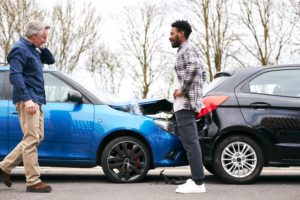Rear-End Collision Injuries
Auto Accidents, Personal InjuriesRear-end collisions frequently happen, usually resulting in extensive injuries and financial losses. You may have legal options if you’ve been in a rear-end collision.
Continue reading to better understand rear-end collisions, including causes, injuries, and compensation. For more information, reach out to a Charleston car accident lawyer.
What is a Rear-End Collision?
A rear-end collision occurs when a driver crashes into the back of the vehicle in front of them. These accidents can occur anywhere at any time but often happen at red lights, stop signs, and busy intersections. They usually involve two cars, but the accident can cause a chain reaction involving more vehicles depending on the situation.
Rear-end collisions are some of the most common types of car accidents. In a recent year, rear-end collisions were the third most frequent cause of car accident fatalities behind angled accidents and head-on collisions.
Common Causes of Rear-End Accidents
Rear-end collisions most frequently happen for any of the following reasons.
Speeding
Speeding is one of the most common causes of all traffic accidents, including rear-end collisions. For more than 20 years, speeding has been a factor in over one-third of all accident fatalities.
Speeding:
- Decreases the control a driver has over their vehicle
- Requires a greater stopping distance
- Increases chances of severe injuries in case of an accident
When people speed, they’re putting themselves and others on the road at risk.
Tailgating
When people tailgate, they follow the car in front of them too closely. If the car in front stops suddenly, the rear vehicle will more than likely crash into them.
Brake Checking
Brake checking is dangerous driving behavior. It involves a driver suddenly slamming on their brakes to scare the driver behind them.
Drivers often brake check to frighten or frustrate the rear driver. Brake checking frequently results in rear-end collisions, as the rear driver has little time and space to stop without hitting the front vehicle. Brake checking is illegal in many states.
Aggressive Driving
Aggressive driving is an umbrella term referring to several dangerous driving behaviors.
Aggressive driving usually involves some or all of the following:
- Speeding
- Following too closely
- Weaving in and out of traffic
- Running red lights and stop signs
- Failing to yield
- Disobeying road signs and traffic laws
When drivers choose to drive aggressively, they drive without regard for others’ safety.
Distracted Driving
Distracted driving is any behavior or combination that physically or mentally distracts a person from the task of driving. Distracted driving can either be visual, physical, or cognitive.
Visual distractions, like texting or picking a song to play, take your eyes off the road. Physical distractions take your hands off the steering wheel, including eating, grooming, or reaching for something. Cognitive distractions, like daydreaming or emotional distress, take your mind off driving.
Impaired Driving
Impaired driving means driving under the influence of alcohol or drugs. When a driver is under the influence, driving safely and responsibly is nearly impossible, therefore causing accidents.
Driver Fatigue
Driving while tired is never a good idea. Not only does a fatigued driver risk dozing off at the wheel, but they also become easily distracted. Reaction times are much slower when a driver is fatigued.
Injuries From Rear-End Collisions
 Injuries resulting from rear-end collisions often vary, as it frequently depends on details like the speed of the vehicles and the severity of the accident.
Injuries resulting from rear-end collisions often vary, as it frequently depends on details like the speed of the vehicles and the severity of the accident.
When rear-ended, your body typically whips forward and backward quickly and violently. Because the significant blow is unexpected, you’re not prepared. This sudden jolt can result in several kinds of injuries, both seen and unseen.
Some of the more common rear-end collision injuries are listed below.
Head and Neck Injuries
Head and neck injuries are among the most commonly experienced injuries after a rear-end collision. When you feel the jolt and your body quickly moves back and forth, the head and neck are affected.
Whiplash is a prominent issue after rear-end accidents. Whiplash occurs after a rapid back-and-forth movement affects your neck. It gets its name because your head and neck mimic the movement made by the cracking of a whip. Symptoms of whiplash include intense neck pain, stiffness, and severe headaches.
The movement of your head during a rear-end collision can also cause your head to hit the steering wheel or back of your seat, resulting in a concussion.
Facial Injuries
Facial injuries are likely to occur with the sudden movement resulting from a rear-end collision. If your face lands on your steering wheel hard enough, you can fracture the bones in your face or break your nose.
Broken Bones
Fractured and broken bones in other parts of the body, like arms and legs, are common, depending on your body’s movement after a rear-end collision. Broken bones can require extensive time in a cast and rehabilitation afterward.
Internal Injuries
Internal injuries are risky because you may not even know you suffered an injury at all. Internal injuries often do not show signs or symptoms, and diagnosis requires X-rays and CT scans.
Certain organs are most at risk for injury during car accidents, including your kidney, spleen, liver, and pancreas.
Internal injuries can also occur because of improper seat belt use. When a collision happens, and your seat belt restrains you, this can easily cause trauma to muscles in the torso, ribs, heart, or bowels.
Back Injuries
Back injuries, especially injuries to the discs in the spine, happen frequently during rear-end collisions. Discs make up the spinal column, running from the neck to the lower back. Injury to these discs can be painful and long-lasting.
Spinal discs are flat and hard with a soft center. When some of the soft center comes out through a tear in the tough exterior, this is called a herniated disc. This can cause pain, tingling, and numbness in the arms, legs, or other parts.
Muscle strains in the back are also common, along with pinched nerves.
Seek Medical Attention for Injuries No Matter What
Immediately after a collision, you may feel like you didn’t suffer any injuries, but you might have. The problem with traumatic events like car accidents is the body’s response to stress. You may be familiar with the term “fight or flight mode,” and that’s exactly what your body does during a collision.
During a trying experience, the body releases adrenaline—the hormone responsible for putting you in fight or flight mode. This is the body’s way of dealing with anything that may happen.
Among the things adrenaline does to your body, it can take away any feelings or sensations of pain. Therefore, even if you suffered an injury, you may feel like you’re walking away unscathed.
After a rear-end collision, even if you don’t think you suffered any injuries, always seek medical attention anyway. Whether you visit an emergency room or see your primary care physician, a thorough medical examination can provide answers regarding injuries you may have sustained and the extent of your harm.
Failing to get medical care can hurt you in the long run, both health-wise and compensation-wise.
Complications and Consequences of Rear-End Collision Injuries
Injuries from rear-end collisions can result in life-altering complications for victims. A rear-end collision injury can have long-term consequences depending on the type of injury and how severe it is.
Some of the complications victims of rear-end accidents frequently suffer include:
- Chronic pain
- Loss of mobility
- Paralysis
- Scarring
- Issues with balance
Victims can also suffer mental and emotional harm, including depression and anxiety.
Rear-end collision injuries can require extensive medical care and rehabilitation, meaning mounting bills and financial strain. Pursuing compensation for your injuries and losses cannot fix all of your problems, but it can relieve some of the undue stress you’ll likely face.
Why Getting and Completing Medical Treatment is Critical
Getting medical treatment is crucial for your health and well-being. Failing to treat your injuries can result in unnecessary complications and frustrations.
Your doctor can recommend medical treatment that’s right for you and your injuries. Whether it’s medication, rehabilitation, or surgery, you can trust your physician to make a treatment plan to get you on the path to maximum physical recovery.
However, you must follow your medical treatment plan as indicated by your doctor. Following your treatment plan is important not only for your physical and mental well-being but also for your future compensation claim.
Medical records play an essential role in car accident claims. Everything should go into your medical records—your diagnoses, treatment plan, medical progress, etc.
When you don’t follow your treatment plan or don’t seem to show an interest in getting treatment as indicated, this can reflect negatively on your medical records. The insurance company can review your medical records and make assumptions with this information – like your injuries were never as serious as you claimed or you were lying.
Completing medical treatment as your doctor prescribes can help ensure you’re doing what’s best for your health and protect your rights to future financial compensation.
Liability for Rear-End Collisions is Challenging
Establishing liability is usually complicated in car accident cases, and the same goes for rear-end collisions.
After a rear-end collision, people usually blame the rear driver. In many cases, the rear driver was distracted or following too closely, meaning they were at fault.
However, this is not always the case. In many cases, the front driver may have been engaging in dangerous driving behaviors, like brake checking or aggressive driving, resulting in a rear-end collision that they caused.
If you were involved in a rear-end collision as the rear driver and the accident was inevitable and not your fault, a car accident attorney can help you. While challenging, a skilled and experienced accident lawyer can build your case and establish the other driver’s liability.
Proving Liability
Proving liability for a rear-end accident involves establishing the other driver was negligent and obtaining evidence to prove this.
First, you must prove the other driver is liable for the accident. This requires satisfying the required elements of negligence:
- The other driver owed you and other drivers a duty of care
- They breached this duty of care
- Their breach was the cause of your rear-end collision
- You suffered injuries and losses as a result
Strong evidence helps prove the other driver is at-fault for the accident. Evidence is especially important for rear-end collisions, especially if you are trying to blame the front driver.
Evidence to indicate fault can include:
- Police reports
- Nearby surveillance footage
- Street camera footage
- Witness statements
- Photos and videos
- Medical records
- Expert statements
Your car accident lawyer knows how to obtain relevant information and use it to your advantage.
Compensation for Rear-End Collision Injuries
If you suffer rear-end collision injuries and someone else was to blame, you can pursue compensation.
After an accident, you’ll undoubtedly experience losses. When the accident is someone else’s fault, you can pursue compensation from their insurance company.
Compensatory damages compensate you for your losses, whether financial or otherwise.
Economic damages are those monetary damages stemming from your collision, including:
- Past and future medical bills
- Loss of earnings
- Lost earning potential
- Property damage
Non-economic damages are also related to your collision but represent intangible losses, including:
- Pain and suffering
- Mental anguish
- Emotional distress
- Permanent impairment
In addition to compensatory damages, you may recover punitive damages. Punitive damages punish defendants for malicious, intentional, or reckless actions rather than negligent ones.
A Car Accident Attorney Can Help You
 A Charleston car accident lawyer has the knowledge and experience to handle your case and seek compensation on your behalf.
A Charleston car accident lawyer has the knowledge and experience to handle your case and seek compensation on your behalf.
Among the many tasks a lawyer can help you with, they can:
- Investigate your rear-end collision
- Gather essential evidence
- Establish liability
- Determine how much your case is worth
- Communicate with the insurer
- Handle settlement negotiations
- Represent your best interests
After a rear-end collision, do not hesitate to discuss your case with a qualified car accident lawyer to pursue maximum financial recovery.
Many people mistake rear-end collisions as simple or straightforward accidents, but this is rarely the case. Questions of liability and severe injuries can complicate matters quickly, and you need the right legal help. For more information, contact us.
Nathan Hughey, an attorney and fourth-generation South Carolinian, founded Hughey Law Firm in 2007. Before that, he spent five years defending nursing homes and insurance companies. Leveraging his experience, he now advocates for those injured or wronged by such entities, securing over $220 million in verdicts and settlements.
